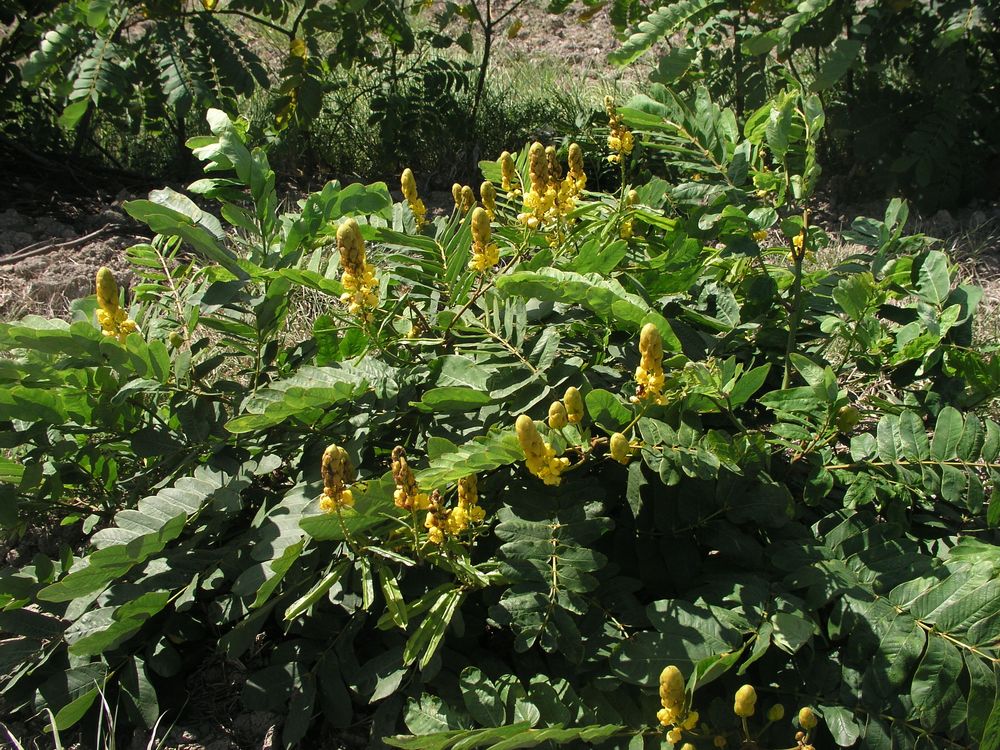Senna alata

|
|
Senna alata Common Names: Candle Bush, Candlesticks, Crawcraw
Plant, Ringworm Plant, Senna, Emperor’s Candlesticks Scientific
Classification Kingdom: Plantae Phylum: Tracheophyta Class: Magnoliopsida Order: Fabales Family: Fabaceae Genus: Senna Species: S. alata Synonyms: Cassia alata L., Herpetica alata (L.) Raf., Cassia bracteata L.f. Morphological Description Senna alata is
a fast-growing perennial shrub or small tree, typically 3–4 m tall,
occasionally reaching 6 m in optimal conditions. Its key features include: · Stem: Erect, smooth, green to reddish-brown, woody at the base · Leaves: Pinnately compound, 30–60 cm long, with 8–20 pairs of oblong
leaflets, 5–15 cm long, 2–5 cm wide, thinly leathery, folding at night · Flowers: Bright yellow, 2–3 cm wide, arranged in dense, erect,
candle-like racemes up to 60 cm long, blooming year-round in tropics · Fruit: Winged pods, 10–20 cm long, green turning blackish-brown,
containing numerous flat seeds The candle-like flower
spikes are a defining ornamental trait (Fern, 2024). Distribution and Habitat Senna alata is
native to the tropical Americas, from Mexico to northern Argentina, and widely
naturalized across Africa, Asia, and Oceania. It thrives in: · Ecosystems: Wastelands, floodplains, forest edges, roadsides, and
coastal areas · Climate: Tropical and subtropical (25–35°C), rainfall 1,000–2,000 mm
annually · Soils: Moist, well-drained, sandy to clayey, tolerating poor
fertility (pH 5.5–7.5) It is often considered
invasive due to its adaptability and prolific seed production (Shackleton et
al., 2018). Ethnopharmacology Senna alata,
commonly known as the ringworm bush or candle bush, is a medicinal plant
renowned for its diverse therapeutic applications. Traditionally, it has been
employed to treat various ailments, including skin conditions such as ringworm,
scabies, eczema, and other fungal infections, owing to its potent antifungal
properties attributed to active compounds like chrysophanic acid. Additionally,
the leaves possess laxative effects due to anthraquinone content, making them
effective in relieving constipation. The plant also exhibits antibacterial,
anti-inflammatory, diuretic, analgesic, hypoglycemic, and antispasmodic
activities, supporting its use in managing conditions like typhoid, diabetes,
malaria, asthma, and rheumatism. Phytochemical analyses have identified bioactive
constituents such as anthraquinones, flavonoids, phenolics, and alkaloids,
which contribute to its pharmacological properties. These findings validate the
extensive traditional use of Senna alata in various cultures for managing a
wide range of health conditions. · Antifungal: Study shows that, Both aqueous and ethanolic leaf extracts
of Cassia alata have demonstrated significant antifungal activity against five
clinical isolates of pathogenic fungi. Notably, the extracts inhibited the
growth of Candida albicans, Microsporum canis, and Trichophyton mentagrophytes
more effectively than the standard antifungal agent ketoconazole at a
concentration of 200 mg, with the differences being statistically significant
(p<0.05). The minimum inhibitory concentrations (MICs) for the aqueous
extract were 26.90 mg for Candida albicans, 32.40 mg for Aspergillus niger,
29.50 mg for Penicillium notatum, 30.30 mg for Microsporum canis, and 27.80 mg
for Trichophyton mentagrophytes. In comparison, the ethanolic extract exhibited
lower MICs: 5.60 mg for Candida albicans, 3.50 mg for Aspergillus niger, 4.90
mg for Penicillium notatum, 12.60 mg for Microsporum canis, and 9.80 mg for
Trichophyton mentagrophytes. These findings highlight the potent antifungal
properties of Cassia alata leaf extracts, supporting their traditional use in
managing fungal infections. (Timothy, 2012). · Laxative: In Ghana, leaf decoctions reduced constipation. · Antimicrobial: In the Philippines, ethanol leaf extracts showed activity
against Staphylococcus aureus (MIC 64 µg/mL), validating skin infection remedies (Oladeji
et al., 2020). · Antidiabetic: In Cameroon, leaf extracts lowered blood glucose by 35% in
diabetic rats at 400 mg/kg, supporting traditional use (Kazeem et al., 2015). · Anti-inflammatory: In Brazil, leaf extracts reduced paw edema
in rats by 45% at 100 mg/kg, attributed to flavonoids (Singh et al., 2012). ⚠ Toxicity Profile: High doses (>1 g/kg) of leaf extracts may
cause diarrhea and electrolyte imbalance due to anthraquinones. LD₅₀ exceeds
5,000 mg/kg in rats, but long-term use risks hepatotoxicity; guidance is
advised (Hennebelle et al., 2009). Additional Uses · Ornamental: Planted for its striking yellow flowers and lush foliage
(Fern, 2024). · Cosmetic: Leaf extracts used in Filipino soaps and shampoos for
antifungal properties (Oladeji et al., 2020). · Ecological: Acts as a pioneer species in disturbed areas, stabilizing
soil. References
External Links |
|
| Compounds of Senna alata | |
| References |